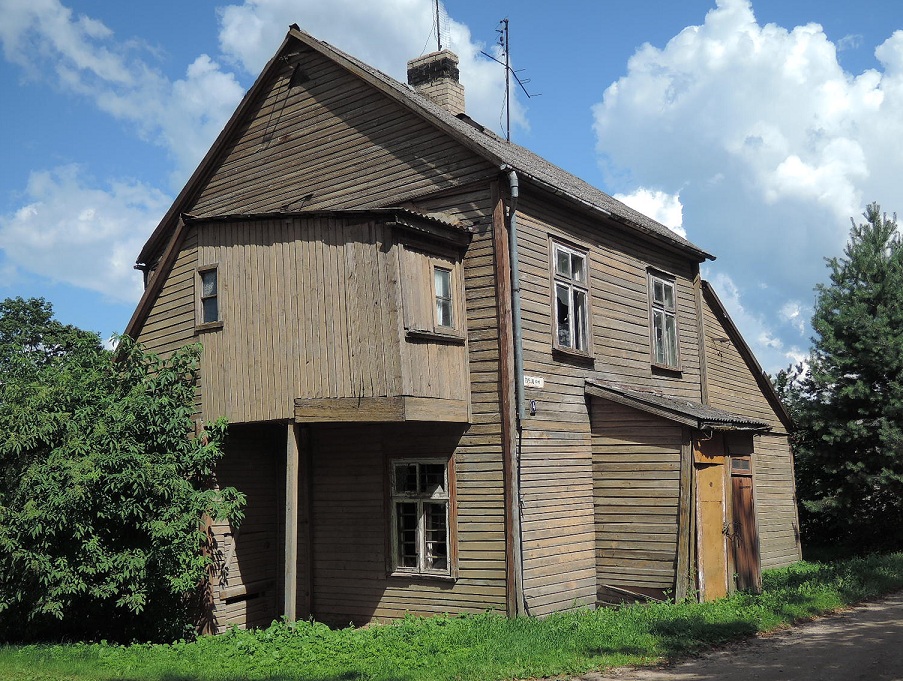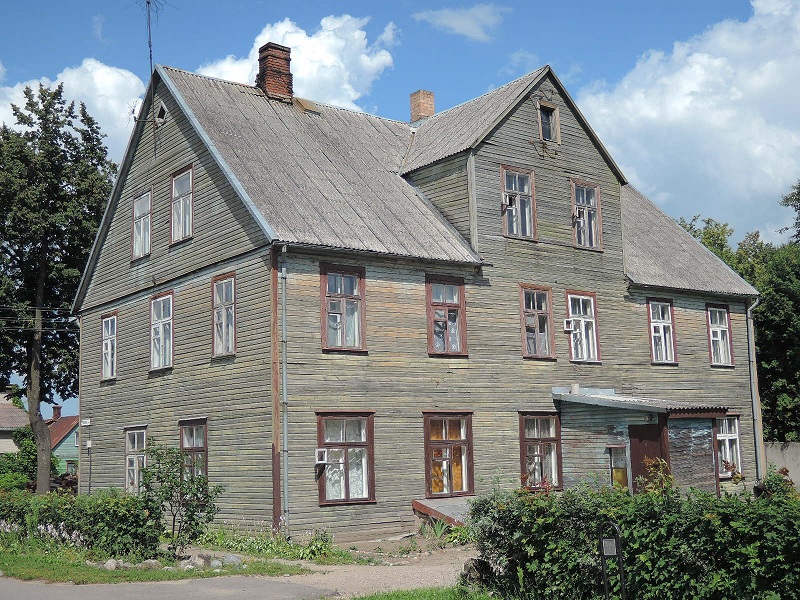Gods felt generous yesterday and gifted me with an endearing and warm experience in Panevezys; but a veteran wayfarer like me knows well that there aren’t two days alike along the road, and that there’s no wisdom in trying to tread twice the same track. We must linger not on the stage of our memories, lest they lose their treats, same as the image is lost on a piece of film that has been twice exposed.
Despite my efforts for dodging the cities, all the roads around this area lead to Riga, and I haven’t had a choice. From Panevezys I’ve taken a secondary route northwards that goes through Birzai, a quiet small town by a lake, where — being close to the border — I thought I’d find some place where to exchange my remaining Lithuanian Litas into Latvian Lats; and there has been a funny tale attached to this endeavour.
Wherever I go in Lithuania I can’t but admire, or even envy, the authenticity and beauty of the houses, and this life style that still preserves fresh the taste of the past century.
As I scan the town in quest for some money exchange booth that I can’t find, instead I come across one of those milkbars, a living legacy from Soviet times I’m so familiar with because of Poland. I didn’t know milkbars also occured in Lithuania, and I seize the chance for having lunch. I never miss an opportunity for enjoying these places, not only for their home made food at ridiculous prices, but mostly because I have the feeling — nay, I’m positive that all of them will soon disappear, swallowed by the fever of “progress” and by the westernizing yearning. One day, there will be not a single milkbar left.
After finishing my light meal I get on Rosaura and head for the neraby border, the tenth I’m crossing this trip. This one runs along the Memele river, where the map places two tiny localities, each on a shore. There has to be here, for sure, some place where to exchange money, I say to myself.
But this place, not showing the smallest trace of a border crossing, is barely a farming village one hundred houses big, with only a small shop on the Latvian side. I ask the tender, whould she buy my Lithuanian banknotes?, but she says ‘only Euros’; which is no use for me, as I want to buy the Lats with my remaining Litas, not with Euros; therefore I carry on.
I’d have liked to find some nice place before Riga to stay overnight, but sooner than expected I see myself on the main road and I don’t come by any place to my entire satisfaction, so I resign myself to sleep in the city.
Riga is the capital of Latvia. I’ve picked a downtown hotel on Gertrudes street, not too far from the river; and once I lock the motorcycle opposite to the hotel’s gate, I go walking to the old town, undisputably fine and splendidly preserved. I enjoy strolling along Riga’s wide cobblestoned streets, lined by old but elegant buildings and underlined by the rails of the tramway, whose traffic bestows a romantic, movie-like air to this city which was left unharmed during WWII. Despite the undeniable beauty of its historical centre — an UNESCO heritage site — I find it to be but a stage, where everything is phony except for the buildings themselves. Being the European Culture Capital for 2014 and operated by several low-cost airlines since 2004, European and Russian tourists overrun Riga’s centre. All over, there are plenty of restaurants and terraces with showy advertising ploys, live music, employees on period attires, or handing out fliers, souvenir shops full to the brim, distasteful night clubs, gorgeous chicks with promises of heavenly pleasures chiselled on their figures, go-getters of all kinds and, as the vital juice, a Babel of tourists spending their money in this life-size amusement park.
And here comes the tale: I’m a bit surprised to find absolutely all prices shown in both Lats and Euros, but I put it down to the superabundant European tourism. Reminded that I still don’t have Lats, I get into a money changer and ask the cashier, can I buy Lats with my Litas? But again –like the shop in the border– she says no, only Euros. This over-eagerness for the European currency starts bothering me. Then I try in a nearby souvernir shop with a money changer inside, and this time I finally get a positive reply; so I give her all my remaining Litas, but to my despair, when she handles me the money I realize it consists of Euro banknotes. Holy shit! I want Lats. Is there nobody going to sell me Lats in Latvia? Then the lady stares at me and says: there are only Euros in Latvia, mister.
This leaves me open-mouthed for a moment, and she calls a workmate speaking better English so as he can teach me the news: since January 2014, Euro is the only official currency in Latvia. Then I start laughing, as this explains everything: the lack of money changers on the border, the converted prices, the unwillingness to sell me Lats… I’ve been the whole day trying to buy a currency that doesn’t exist any longer! Such an absent-mindedness!This is what happens, dear friends, when you want to keep a live on the fringes of the news…
Then, upon watching carefully, I realize that most prices are not round: things cost € 1.58 or € 4.12, for instance, which is bizarre, but evidences that these people have respected the exchange and overcome temptation for rounding up, unlike the first Euro countries did. Perhaps this is due to Latvian Government’s recommendation for avoiding inflation, but however it be, bless their lack of slyness! I wonder how long will it take for them to get spoiled like we got.




